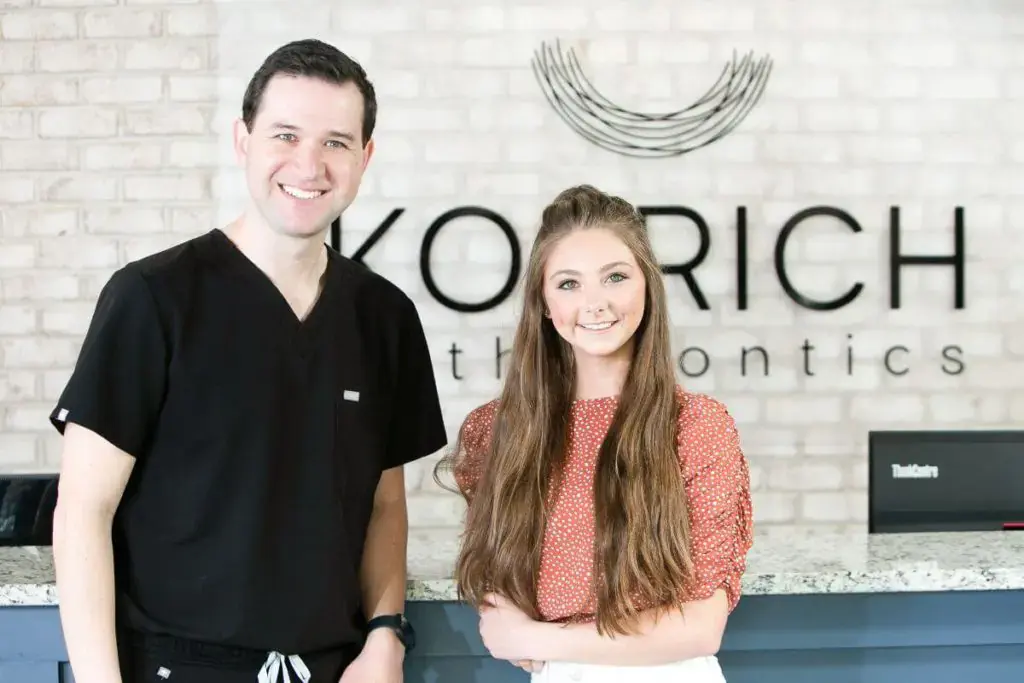Here at Koerich Orthodontics, we’re all about giving patients a confident smile they’re proud to share with everyone around them. If you have a “gummy” smile, you may be unhappy with the way it looks and have become used to covering it up over the years. Prominent gums can affect the cosmetic appearance of your smile and leave you feeling self-conscious, but our expert team is here to help! To learn more about what causes a gummy smile and can it be corrected, keep reading below.
What is a gummy smile?
Gummy smiles, or excessive gingival displays, occur when more than 4 millimeters of gum tissue shows when a person smiles. That’s just over 1/8 of an inch, which seems small, but can have a big impact!
What causes a gummy smile?
There are several possible reasons for an excess of gum tissue, so it’s important to work with your dental and orthodontic providers to understand the root cause of your gummy smile. This helps to ensure you receive the most effective treatment to improve and emphasize your natural smile! We’ll look at some of the most common causes here.
Your gums—Teeth that appear too short in relation to your gums may be covered by an excess of gum tissues.
Your teeth—Teeth can sometimes emerge in the mouth at different heights, with some growing in lower than others. A tooth grinding habit can also wear the teeth down over time and cause them to become shorter. This can lead to something known as compensatory eruption, where the teeth begin to slowly move outward from the gum to compensate for the extra wear and tear. Any of these scenarios can give the smile a gummy appearance.
Your upper lip—The average upper lip moves 6 to 8 millimeters from its normal resting position to achieve a full smile. A hypermobile upper lip tends to rise much further than that, revealing additional gum tissue.
Your jaw—Sometimes the upper jaw, or maxilla, is too long for the face. This condition is referred to as Vertical Maxillary Excess (VME) and can be treated with orthognathic surgery.
How can a gummy smile be treated?
Your smile line describes the teeth that show when you smile. This is determined by several factors, including:
- the shape and size of your lips
- the size and shape of your teeth
- your facial muscles
- your gum tissue
An optimal smile line will reveal the least amount of gum tissue possible. The goal is to balance the visible gum and create even contours that are in harmony with the upper lip. When there is a noticeable imbalance in these elements, it can result in a gummy smile. Aesthetics aren’t the only thing affected by excess gum tissue, though! If there are any underlying dental conditions present, like abnormal tooth eruption or jaw development, it could mean you have a misaligned bite with the potential to impact your long-term oral health. Let’s look at some of the treatments available to address issues associated with a gummy smile!

Orthodontic treatment
If you have a gummy smile that’s caused by a bad bite, orthodontic treatment like braces or clear aligners can help. These appliances will correct the bite and reduce the amount of gum tissue that shows when you’re smiling, laughing, or talking. There are other benefits to orthodontic treatment as well! Aligning your smile can also alleviate symptoms like persistent headaches and jaw or neck pain.
Scaling and root planing
When a gummy smile is caused by inflamed or infected gums, the best place to start is with a deep professional dental cleaning, also known as scaling and root planing. This advanced cleaning can reach deep into the gum pockets around each tooth to remove bacteria and help any infection heal. Once the infection is gone, inflammation will normally subside, reducing the gummy appearance of the smile.
Veneers or crowns
If there aren’t any major underlying issues causing a patient’s gummy smile, veneers or crowns are often excellent non-invasive treatment options. These are attached to the teeth to make them appear longer, larger, and more proportionate to the gums.
Gum lift or crown lengthening
When too much gum tissue is covering the teeth, a gum lift or crown lengthening may be the best treatment option. A gum lift procedure removes some of the tissue around the teeth and restructures the gum line to be higher. The end result is a patient’s smile showing more teeth than gums. If there’s an abundance of gum tissue present, crown lengthening treatment may also be recommended. This not only restructures the gums but also changes the bone around the teeth.
Lip lowering
This treatment doesn’t literally lower your lip. Instead, a small section of gum tissue under the upper lip is removed before the top and bottom are stitched together. This creates a shorter lip that isn’t able to rise as high as it used to, covering more of the gum tissue and reducing the appearance of a gummy smile.
Botox treatments
Botox can also be helpful for hyperactive upper lips! Injecting Botox into the upper lip will limit its range of movement, reducing the amount of gum tissue shown when smiling. This is a minimally invasive solution that wears off in about 3-6 months.

Get the confident smile you deserve at Koerich Orthodontics
A gummy smile isn’t always due to an underlying dental issue that needs to be fixed. Treatments like crowns, veneers, and crown lengthening are minimally invasive and help your gums look more proportionate to your teeth. Depending on your needs and goals, you can also choose between permanent and temporary solutions.
If you have a gummy smile and would like to learn more about your options for treating it, our expert team will be happy to walk you through them. Get in touch today to schedule a FREE consultation and take the first step towards the confident smile you deserve!



